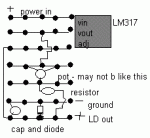- Joined
- Jul 28, 2007
- Messages
- 61
- Points
- 0
Daedal said:I highly doubt it...
GL;
DDL
Oh well, not a big deal. What's important is that the circuit works and seems to do its job well. I am considering modifying my lower powered red with the same circuit. Right now, it just has a dropping resistor.
BTW, the total resistance I did calculate after I changed resistances until the current was where I wanted it. Comes out to only about 5.8 ohms for ~165 mA.
Thanks again,
Jon




